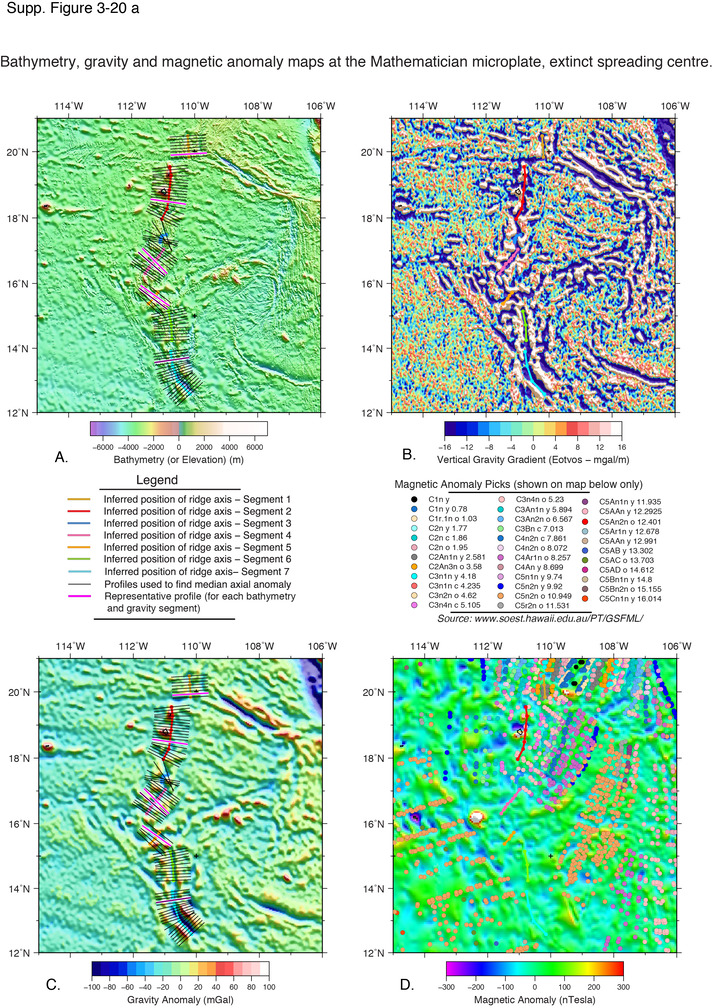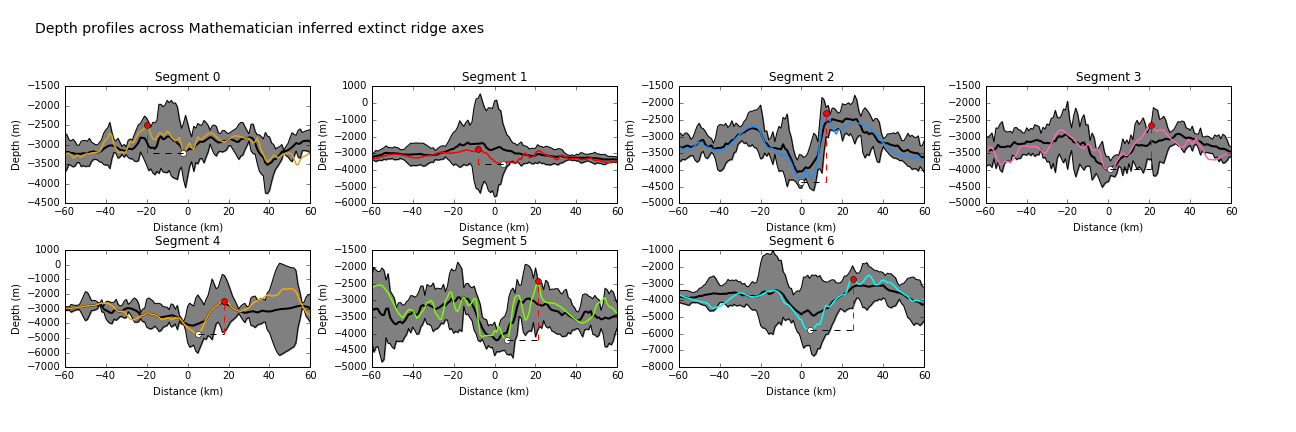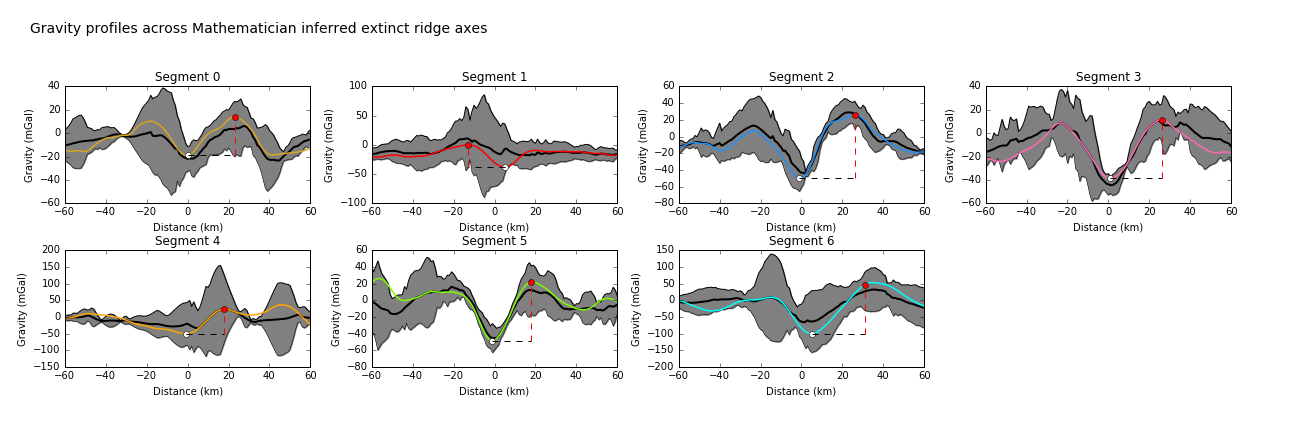| Ocean: | Pacific |
| Spreading centre type: | Microplate spreading ridge |
| Time of cessation: | Between 6.5 and 3.5 Ma, chron C3n4n (Batiza and Vanko, 1985) |
| Subsequent active spreading centre: | Pacific-Rivera spreading centre |
| Cessation style: | Klitgord and Mammerickx (1982) suggested a gradual and diachronous slowing and cessation from south to north over around 3 million years, but the timing is poorly constrained (Batiza and Vanko, 1985). |
| Later deformation or volcanism: | Modern, alkali-basalt eruptions are reported on Mathematician ridge transform faults and south of the Clipperton FZ (both examples reported in Batiza and Vanko, 1985), but may be related to influence from the proposed Socorro hotspot (Zhao, 2007). |
The Mathematician extinct spreading centre is found offshore of Acapulco, Mexico and to the south of the Baja California peninsula, to the west of the northernmost tip of the active East Pacific Rise (EPR). The Mathematician extinct spreading centre was reported by Sclater et al. (1971), whom suggested that a ridge-jump to the east had occurred at ca. 5 Ma. Sclater et al.'s (1971)early interpretation was that the elevated ridge Mathematician Ridge, at depth 3-4000 m was likely to have been the axis of spreading prior to migration to the EPR. Sclater et al. (1971)’s also suggested that the Clipperton seamount chain may represent an additional spreading centre.
Klitgord and Mammerickx (1982) and Mammerickx et al., (1988) extended the detailed mapping of the structure and the definition of the limits of the paleo-microplate that was formed at the extinct microplate spreading centre (Mammerickx et al., 1988). While the East Pacific Rise spreading system is currently creating crust at a north-south oriented ridge due to fanned spreading, the Mathematician would have been oriented to the north-east, oblique to the previously formed crust. Its formation is thought to be related to a complex reorganization of plate boundaries at around 12.5 Ma (Klitgord and Mammerickx, 1982). South of the O’Gorman fracture zone the tectonic fabric is less clear in the interpretation of Klitgord and Mammerickx, (1982), yet the later work of Mammerickx et al. (1988), proposes that the fracture zone formed a southern transform fault, that bounded the Mathematician plaeoplate. It is possible that the area to the south was formed in an alternately oriented spreading centre, similar to the configuration of the complex of microplate centres found in proximity to the Magellan Trough (Nakanishi et al., 1989).
Mammerickx et al. (1988) produce the most detailed interpretation of the Mathematician ridge and microplate and differ from previous interpretations of the region in that they propose that two spreading centres were active on either side of the paleoplate during its formation. They define these as the Mathematician Ridge and the Moctezuma Troughs. The tectonic scenarios by which a ridge jump could have occurred there are illustrated in their Figure 13 (Mammerickx et al., 1988).
Klitgord and Mammerickx (1982) argue that the Mathematician Ridge ceased as a result of gradual propagation of the Pacific-Rivera spreading centre to the north, which led to rotation of the spreading centre and microplate crust and eventually to spreading cessation.
The Mathematician microplate spreading ridge segments are considered as examples of well-defined extinct ridge segments and are type-examples.
Batiza, R. and Vanko, D.A., 1985, Petrologic Evolution of Large Failed Rifts in the Eastern Pacific: Petrology of Volcanic and Plutonic Rocks from the Mathematician Ridge Area and the Guadalupe Trough. Journal of Petrology, v. 26, p. 564–602.
Klitgord, K.D. and Mammerickx, J., 1982, Northern East Pacific Rise: Magnetic anomaly and bathymetric framework, Journal of Geophysical Research, v. 87, no. 2, p. 6725.
Mammerickx, J., Naar, D. and Tyce, R., 1988. The Mathematician paleoplate. Journal of Geophysical Research, 93, p. 3025–3040.
Nakanishi, M., Tamaki, K. and Kobayashi, K., 1989. Mesozoic magnetic anomaly lineations and seafloor spreading history of the northwestern Pacific. Journal of Geophysical Research, v. 94, p. 15,437-15,462.
Sclater, J.G., Anderson, R.N. and Bell, M.L., 1971, Elevation of ridges and evolution of the central eastern Pacific, Journal of Geophysical Research, v. 76, no. 32, p. 7888–7915.
Zhao, D., 2007, Seismic images under 60 hotspots: Search for mantle plumes, Gondwana Research, v. 12, no. 4, p. 335–355.


